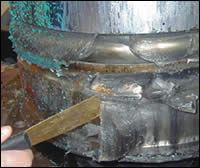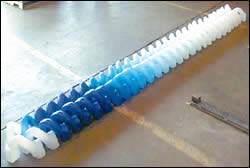Less Downtime = More Profits With Accumulator-Head Machines
A fundamental challenge in operating accumulator-head extrusion blow molding machines is to minimize downtime.
A fundamental challenge in operating accumulator-head extrusion blow molding machines is to minimize downtime. Accumulator-head units excel at making large hollow ducts, panels, drums, and toys. However, in a highly competitive market dominated by low- to mid-volume applications, the major threat to using this equipment profitably is long, costly downtimes linked to transitions between different materials, colors, and parts.
The molding system—including machine, head, mold, and handling equipment—is expensive. A workhorse dual-head, 190-ton system with a 15- to 30-lb head typically costs $1 million to $1.5 million. The molder’s profitability rests on collecting high billing rates (about $105/hr) and keeping uptime at 95% or higher. Those requirements may conflict with production schedules that require frequent changeovers:
uResin and color changeovers involve downtimes of 3 to 15 hr with lost-opportunity cost estimated at $310.40 per hour (see table).
- Head and mold changes generally impose 6 to 8 hr of downtime at a lost-opportunity cost of about $200/hr.
- Set-up and start-up times average around 3 hr and cost $300/hr in lost production.
- The easiest and most direct route to boosting profit is to streamline these changeovers. The good news is that this is readily feasible, and any downtime reductions go straight to the bottom line.
Purge or hand clean?
Accumulator heads tend to be intricate in detail, so material and color hang-ups are an everyday concern. Given a lost-opportunity cost of $310.40/hr cost and a 9-hr average changeover time, just one change per machine per week causes annual profit forfeiture of $145,000.
One response is to use chemical purging compounds, which attack residual material in inaccessible zones of the head, loosening long-dormant materials or colors. The trouble is that “awakening” those stagnant areas in the head often increases the “bleed time” needed to eliminate streaks or black specks in parts. In a good many cases, chemical purging actually increases downtime. (Editor’s note: For a contrary view, see PT, Feb. ’03, p. 50.)
A more promising approach is purging with natural resin. This is most viable with new-generation heads that incorporate spiral diverters and other features that reduce hang-up areas. In such cases, purging can often eliminate residual color in as little as 30 to 90 min.
Purging time varies with the materials involved. Color changes from black to white and from primary to secondary color tend to require extended purge runs. Planning production so that light colors precede dark colors will require less purge time. Even in the worst cases, careful planning can drive your scrap losses down to zero. For instance, in changing from red to yellow, purgings can be separated by dominant color and reused in parts of similar color. Mixed-color scrap can also be disguised by reuse in black parts.
An example of a challenging material change is shifting from an opaque, rigid, high-temperature PC/ABS to a clear, flexible, lower-temperature acrylic. In such cases, it might be advisable to clean the head manually. No purging material would be used and much less scrap generated.
Manual cleaning of heads is easier with new-generation designs because they are designed to permit quick disassembly and give better access to hang-up zones. With such heads, manual cleaning often can be done rather quickly. It is critical, however, to use only soft (e.g., bronze) tools, and workers must be trained to avoid damaging the head during cleaning.
Plan your changes
A second source of downtime is change overs required when shifting from one job to the next. Two sets of tooling (head tools and blow molds) have to be changed, and they typically include large numbers of electrical, hydraulic, and pneumatic line connectors.
In this situation, paying upfront for advanced tooling generally pays off. It’s best to buy tools that have quick-connect features. Tools with air and water manifolds that connect directly to the mold or back-up plates also reduce mounting times. Molds scheduled to go into production should be cleaned and checked prior to being sent out for loading onto the machine.
Blow tools tend to be heavy and unwieldy, so accurate centering is also a challenge. This step can be speeded by using tools with locating lugs and pins. It is usually better to use overhead hoists rather than forklifts to mount and center the blow mold, hoists being quicker and safer. Return on investment is rapid for modestly priced hoist equipment.
| Hourly Cost of Material or Color Changea | |
| Item Laborb Utilities Billable Machine Rate Purging Material Miscellaneousc Total Cost | $/Hr 27.00 0.40 105.00 150.00 28.00 310.40 |
| aWorkhorse dual-head machine with head size under 30 lb. bTwo operators, including wages and benefits. cIncludes material handling, grinding, color, air. | |
Most jobs involve an extensive package of necessary items like pre-pinch bars, blow stands, needles, and fixtures. It is critical to go over a checklist of these items before mold-change operations begin. Nothing is more frustrating than having to wait during downtime for seemingly unimportant parts to be tracked down or replaced. Special caution is needed when a mold is shipped from another molder: Critical components are often missing, possibly because they belonged to the previous molder.
A final challenge is to ensure a quick transition between set-up and making an acceptable part. This process can take from 3 to 5 hr for new jobs and 2 to 3 hr for existing ones. In new set-ups, it is important to save the data for future use.
Operators charged with set-up responsibility should be trained to follow a logical sequence like the following: Match parison length to cavity dimensions; optimize shot weight; eliminate thick and thin spots.
Related Content
PBT and PET Polyester: The Difference Crystallinity Makes
To properly understand the differences in performance between PET and PBT we need to compare apples to apples—the semi-crystalline forms of each polymer.
Read MoreWhy (and What) You Need to Dry
Other than polyolefins, almost every other polymer exhibits some level of polarity and therefore can absorb a certain amount of moisture from the atmosphere. Here’s a look at some of these materials, and what needs to be done to dry them.
Read MoreTunnel Gates for Mold Designers, Part 1
Of all the gate types, tunnel gates are the most misunderstood. Here’s what you need to know to choose the best design for your application.
Read MoreAre Your Sprue or Parts Sticking? Here Are Some Solutions
When a sprue or part sticks, the result of trying to unstick it is often more scratches or undercuts, making the problem worse and the fix more costly. Here’s how to set up a proper procedure for this sticky wicket.
Read MoreRead Next
Lead the Conversation, Change the Conversation
Coverage of single-use plastics can be both misleading and demoralizing. Here are 10 tips for changing the perception of the plastics industry at your company and in your community.
Read MoreAdvanced Recycling: Beyond Pyrolysis
Consumer-product brand owners increasingly see advanced chemical recycling as a necessary complement to mechanical recycling if they are to meet ambitious goals for a circular economy in the next decade. Dozens of technology providers are developing new technologies to overcome the limitations of existing pyrolysis methods and to commercialize various alternative approaches to chemical recycling of plastics.
Read MoreWhy (and What) You Need to Dry
Other than polyolefins, almost every other polymer exhibits some level of polarity and therefore can absorb a certain amount of moisture from the atmosphere. Here’s a look at some of these materials, and what needs to be done to dry them.
Read More

















.png;maxWidth=300;quality=90)









